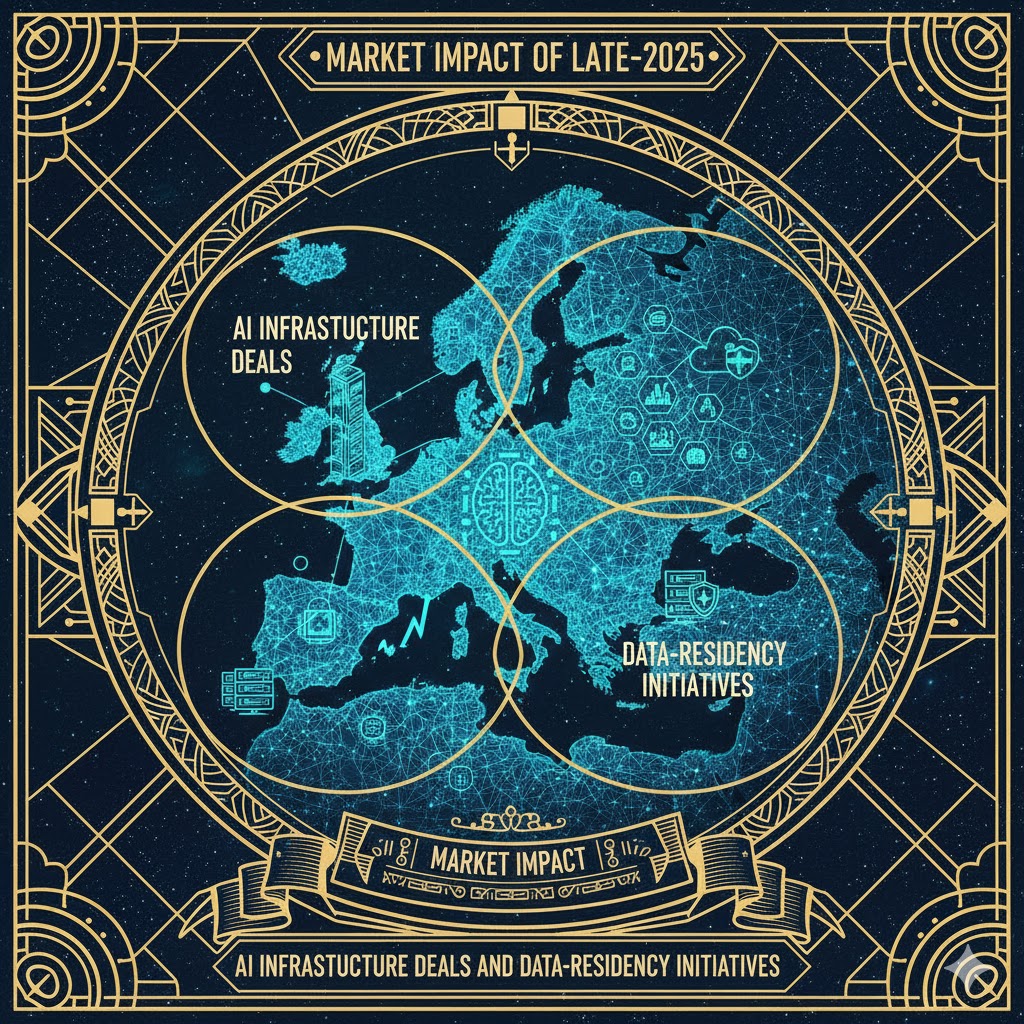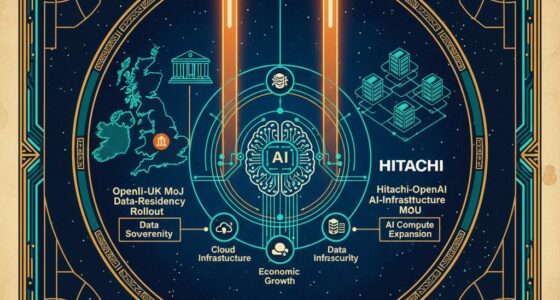1. Hitachi–OpenAI data‑centre partnership (Oct 2025)
Overview
- MoU details – Hitachi and OpenAI signed a memorandum of understanding on 2 Oct 2025 and announced it publicly on 21 Oct 2025. The agreement covers joint planning and development of next‑generation AI data‑centre infrastructure and solutions across several key areashitachi.com:
- Minimising the load on power‑transmission and distribution networks and achieving zero‑emission data centreshitachi.com.
- Securing supply of long lead‑time equipment such as transformers and cooling systemshitachi.com.
- Standardising prefabricated/modular data‑centre designs to shorten construction timelineshitachi.com.
- Co‑designing cooling, storage and other equipment for fast, reliable deployment of AI data centreshitachi.com.
- Integrating OpenAI’s language models into Hitachi’s Lumada/HMAX solutions to enhance digital offeringshitachi.com.
- Context – Hitachi’s energy business is investing more than US$1 billion in high‑voltage power‑grid equipment to meet surging AI‑data‑centre demandhitachi.com. In the U.S. alone, Hitachi plans to build a $1 billion facility in Virginia to manufacture large power transformers because U.S. AI data centres are expected to triple their energy use to ~12 % of domestic power supply within three yearsreuters.com.

Market impact and vertical benefits
| Area/vertical | Potential impact (opportunities & threats) | Competition implications |
|---|---|---|
| Power‑grid & energy equipment | The partnership positions Hitachi as a preferred supplier of transformers, high‑voltage equipment and liquid‑cooling systems for AI data centres. The MoU’s focus on reducing grid load and securing long‑lead‑time equipment suggests a pipeline of multi‑billion‑dollar orders. Hitachi’s $1 billion investment in the U.S. for transformer manufacturingreuters.com underscores how AI data‑centre demand is reshaping the grid‑equipment market. | Competing suppliers such as Siemens, ABB, GE Vernova and Schneider Electric must accelerate R&D into 800‑V, liquid‑cooled architectures and secure manufacturing capacity. The partnership raises barriers for late entrants by combining OpenAI’s brand with Hitachi’s supply‑chain scale. Utilities may increasingly specify Hitachi‑OpenAI designs in new grid‑tender RFPs. |
| Datacentre construction & modular providers | Standardising prefabricated moduleshitachi.com could shorten deployment times and lower CapEx per MW. Players such as Schneider, Vertiv and Rittal may respond with integrated grid‑aware modules and micro‑grid options. Construction firms will need to partner with equipment vendors to offer power‑aware designs. | The collaboration may accelerate adoption of 800‑V DC architectures; competitors will need to match efficiency and sustainability claims or risk being excluded from hyperscale projects. |
| Cooling & HVAC | Hitachi’s experience in industrial cooling gives it an advantage as AI chips move to liquid‑immersion or direct‑chip cooling. Integrating cooling into overall grid‑aware design reduces energy wastage. | Competing cooling vendors must integrate with grid‑management systems and meet stringent Power Usage Effectiveness (PUE) targets. Market consolidation could follow as data‑centre operators look for one‑stop‑shop solutions. |
| Cloud/AI infrastructure providers | OpenAI’s need for rapid data‑centre expansion highlights the scarcity of available power. By co‑designing infrastructure with Hitachi, OpenAI reduces dependence on hyperscale public clouds and may create its own physical footprint. | Hyperscalers like Microsoft, Amazon (AWS) and Google will likely accelerate their own grid partnerships (e.g., Google’s €5 billion Belgian investment)reuters.com. Regional cloud providers may partner with local utilities to secure power allocations, intensifying competition for grid capacity. |
Broader implications
- Sustainability and ESG – The partnership’s goal of zero‑emission data centres and grid‑load minimisation aligns with ESG mandates. Utilities and regulators may adopt efficiency benchmarks derived from this project.
- Industrial AI leadership – The integration of OpenAI’s models into Hitachi’s Lumada products indicates that industrial players are moving beyond generic cloud services toward domain‑specific AI. Customers in manufacturing, rail and energy may benefit from AI‑powered maintenance and design tools.
2. UK data residency & ChatGPT deployment in government (Oct 2025)
Overview
- Agreement with the UK Ministry of Justice (MoJ) – On 23 Oct 2025 the UK MoJ and OpenAI announced that 2,500 civil servants would receive access to ChatGPT Enterprise. The trial demonstrated time‑saving benefits for drafting, compliance, research and document analysisopenai.com. The MoJ plan supports the department’s AI Action Plan for Justice, which aims to modernise public servicesopenai.com.
- UK data residency – OpenAI introduced a UK data‑residency option for its API Platform, ChatGPT Enterprise and ChatGPT Edu. From 24 Oct 2025, customers can choose to store data within the UKopenai.com, separate from the Stargate UK infrastructure (a local AI‑factory partnership with NVIDIA and Nscale). This ensures compliance with GDPR and other UK privacy requirementsopenai.com.
- Reuters confirmation – Reuters notes that the plan lets businesses and the government store data in the UK, enhancing privacy and resilience to cyber‑threatsreuters.com. UK Deputy Prime Minister David Lammy highlighted time savings from the pilot and said more than 1,000 probation officers would use AI transcription tools to save hours of manual note‑takingreuters.com.
Market impact and vertical benefits
| Area/vertical | Impact & benefits | Competitive implications |
|---|---|---|
| Public sector (central & local government) | AI tools like ChatGPT are now usable under UK data‑residency rules. The pilot showed that generative AI can reduce routine drafting and compliance tasks from half a day to minutesopenai.com, freeing civil servants for higher‑value work. MoJ expects to roll out enterprise‑grade AI to 90,000 staff by Dec 2025technologymagazine.com. | Competing AI vendors (Anthropic, Mistral, Google) will need to offer local data‑residency and robust security to win public‑sector contracts. Systems integrators (Accenture, Capgemini) may build sovereign AI platforms to serve multiple government departments. |
| Financial services & regulated industries | UK banks, insurers and law firms can adopt ChatGPT Enterprise under local data‑residency, meeting GDPR and FCA compliance. The UK ranks among OpenAI’s top‑five markets for paid subscriberstechnologymagazine.com, signalling pent‑up demand. | Competing providers may form alliances with local telecoms (BT, Vodafone) to host AI models within the UK. Fintechs could differentiate by embedding generative AI into compliance and risk workflows. |
| Education and research | ChatGPT Edu with UK data‑residency allows universities to use generative AI for research summarisation, coding support and teaching while keeping student data in‑country. | Edtech firms will need to match these protections. Some may build on top of OpenAI’s UK API; others may partner with domestic AI labs. |
| Legal and professional services | Lawyers and consultants benefit from AI summarisation and drafting while complying with confidentiality rules. Generative AI may reduce billable hours for routine tasks but create higher‑value advisory services. | Competition among large law firms may centre on AI literacy and integration; firms that adopt early could capture market share. Vendors providing AI‑augmented contract review (e.g., Harvey AI) may use local data centres to compete. |
Broader implications
- Sovereign AI – The separation of Stargate UK (providing local compute) and the new data‑residency feature shows a multi‑layer approach to sovereigntyopenai.com. This may become a template for other countries (e.g., Germany or France) seeking to host AI models.
- Benchmark for responsible AI adoption – The MoJ’s roll‑out emphasises training, governance and evaluation of time savingstechnologymagazine.com. Private-sector deployments can replicate this governance‑first approach to manage risk.
3. Belgium’s grid‑capacity reform for AI data centres (Oct 2025)
Overview
- Elia proposal – Belgium’s grid operator Elia proposed creating a separate category for data‑centre connections with electricity‑allocation caps. This aims to prevent other industries from being squeezed out by the surge in AI‑driven demandreuters.com. Requests for data‑centre capacity have increased nine‑fold since 2022, and reserved capacity for 2034 exceeds double the 8 TWh foreseen in national grid plansreuters.com.
- Flexible connections – Elia said flexible connections with limited access during grid congestion will remain possible, ensuring other sectors aren’t blockedreuters.com. The proposal will be addressed in the 2028–2038 federal grid plan, according to the energy ministerreuters.com.
- Investment context – Google plans to invest €5 billion in Belgian data‑centre campuses to support AIreuters.com. Such commitments pressure the grid, highlighting the need for allocation rules.
Market impact and vertical benefits
| Area/vertical | Impact & benefits | Competitive implications |
|---|---|---|
| Data‑centre developers | Caps on grid capacity mean developers must secure power reservations early, invest in on‑site generation or battery storage, and optimise energy efficiency. This may slow unlimited hyperscale expansion but encourage distributed/edge data centres. | Countries with looser energy caps (e.g., Ireland, Netherlands) may become more attractive, increasing competition among European nations for AI investments. Developers may lobby for renewable‑energy credits or co‑locate with industrial symbiosis projects. |
| Renewable‑energy & storage providers | Grid constraints create opportunities for solar, wind and battery projects co‑located with data centres to provide flexible capacity. Providers can sign long‑term power‑purchase agreements (PPAs) with AI firms. | Competition intensifies between utilities and independent power producers to supply green power. Vertical integration (e.g., Amazon building its own wind farms) becomes more appealing. |
| Industrial & manufacturing sectors | Allocation caps protect manufacturing and other industries from being priced out of grid connections. This ensures that AI data‑centre demand does not crowd out energy‑intensive manufacturing or chemical plants. | Manufacturers might support caps politically to maintain grid access. Data‑centre operators will need to demonstrate community benefits to win permits. |
| Policy & regulation | Belgium’s approach could serve as a model for other EU countries where grid capacity is limited. Regulators may require data centres to implement demand‑response measures and pay for grid upgrades. | Countries like Germany and France might adopt similar frameworks, increasing the need for cross‑border energy markets and infrastructure harmonisation. |
Broader implications
- The proposal underscores that power, not floor space, is the new bottleneck for AI. Data‑centre strategies must integrate power‑sourcing, grid partnerships and sustainability from inception.
- Expect more public‑private partnerships where grid operators, governments and AI companies co‑finance infrastructure upgrades.
4. Allied Irish Banks (AIB) deployment of Microsoft Copilot (Jul 2025)
Overview
- Deployment scale – On 10 Jul 2025, AIB and Microsoft announced that the bank would roll out Microsoft 365 Copilot tools to over 10,000 employees across Outlook, Word, Excel, Teams and PowerPointnews.microsoft.com. The roll‑out embeds generative AI into routine workflows such as forecasting, reporting and collaborationnews.microsoft.com.
- Strategic objectives – AIB’s AI Centre of Excellence is using Copilot Studio to build tailored solutions that synthesise customer insights and speed decision‑makingnews.microsoft.com. The bank plans to introduce GitHub Copilot for developers to accelerate secure software developmentnews.microsoft.com. Research cited by AIB predicts AI could add €250 bn to Ireland’s economy by 2035, with AI adoption in Ireland rising to 91 % (up from 49 % in 2024)news.microsoft.com.
- Employee sentiment and governance – AIB emphasises training, peer learning and engagement with the Financial Services Union to ensure responsible deploymentnews.microsoft.com. In comments to Computer Weekly, CTO Graham Fagan said the bank’s AI Centre of Excellence ensures deployments are secure, purposeful and people‑centriccomputerweekly.com.
Market impact and vertical benefits
| Area/vertical | Impact & benefits | Competitive implications |
|---|---|---|
| Retail & commercial banking | AIB’s scale demonstrates viability of enterprise generative AI. Copilot can reduce time spent on drafting, summarising and reporting, freeing employees to focus on customer service. Banks can also use AI to synthesise customer data and improve decision‑making, potentially reducing credit‑risk assessment time. | Other banks (e.g., Bank of America, NatWest) are likely to accelerate generative‑AI deployments to remain competitive. Vendors like Microsoft, Google, IBM and AWS will compete fiercely for banking contracts, emphasising integration with core banking platforms and compliance features. Smaller challengers may partner with fintechs offering domain‑specific AI. |
| Financial services development & IT | GitHub Copilot reduces coding time and helps maintain secure code. This could shorten development cycles for new digital products (e.g., mobile banking apps or risk‑analysis tools). | Dev‑tool providers (e.g., JetBrains, Atlassian) may integrate AI to stay relevant. The rise of AI coding assistants increases demand for AI‑augmented DevSecOps platforms. |
| Risk & compliance | Generative AI can automate regulatory reporting and risk modelling, but also raises concerns about hallucinations and data leakage. AIB’s governance‑first approach sets a benchmark for risk managementcomputerweekly.com. | Consulting firms (Accenture, Deloitte) offering AI‑risk assessments may see increased demand. Regulators could issue guidance requiring human oversight and audit trails for AI outputs. |
| Employee productivity & workforce dynamics | The bank plans training to build AI fluency, anticipating shifts in job roles. Reducing manual tasks may allow redeployment of staff to advisory roles. | Unions and workers will scrutinise AI’s impact on jobs. Banks that involve staff and unions early may avoid backlash; others risk reputational harm. |
Broader implications
- AIB’s deployment signals that enterprise adoption at scale is now feasible. Early benefits will pressure peers to act quickly or risk falling behind in efficiency and customer experience.
5. Danish Centre for AI Innovation (DCAI) and WEKA sovereign AI platform (Oct 2025)
Overview
- Launch of sovereign AI factory – On 23 Oct 2025, the Danish Centre for AI Innovation (DCAI) and storage‑software vendor WEKA announced the launch of one of Europe’s first fully sovereign, end‑to‑end encrypted AI infrastructure platformsprnewswire.com. The platform unifies high‑performance compute (NVIDIA GPU clusters) with 140 PB of storage (80 PB performance‑optimised NVMe SSDs running WEKA’s NeuralMesh software)prnewswire.com.
- Capabilities – Customers can now manage end‑to‑end AI workflows (data ingestion, training, deployment) within a single systemprnewswire.com. The architecture offers sub‑millisecond latency for training and inferenceprnewswire.com and eliminates IO bottlenecks by pairing NeuralMesh with Gefion’s GPU clusterprnewswire.com. It reduces energy consumption and operational complexity through a single‑tier, software‑defined designprnewswire.com.
- Regulatory focus – The platform provides end‑to‑end encryption, zero operator access and full compliance with EU data sovereignty mandatesprnewswire.com. Broader onboarding for enterprise, research and government customers is planned for Q1 2026prnewswire.com.
Market impact and vertical benefits
| Area/vertical | Impact & benefits | Competitive implications |
|---|---|---|
| European AI & HPC infrastructure | By integrating compute and storage with sovereign controls, DCAI addresses a gap between hyperscaler performance and data‑sovereignty requirements. European researchers, startups and public‑sector bodies gain an alternative to U.S. hyperscalers, enabling them to train large models without exporting data. | Hyperscalers (AWS, Microsoft Azure, Google) may respond by building sovereign EU regions with dedicated storage/compute and zero operator access, or by partnering with national supercomputing centres. Start‑ups like Aleph Alpha and Mistral could use DCAI’s platform to scale models locally, intensifying competition with OpenAI. |
| Regulated industries (healthcare, finance, government) | The platform allows sensitive data (e.g., health records, financial transactions, defence information) to be processed within compliant infrastructure. Sub‑millisecond latency supports real‑time inference for medical diagnostics or high‑frequency trading. | Providers of vertical AI applications (e.g., Siemens Healthineers, Dassault, SAP) can build on the platform to offer localised AI solutions. Traditional HPC providers may need to integrate secure storage to stay competitive. |
| AI start‑ups & research labs | Access to exascale‑class infrastructure with cost‑effective pricing enables experimentation. The zero‑copy architecture increases GPU utilisation, which can reduce training costsprnewswire.com. | Start‑ups may choose DCAI over public clouds for unique sovereignty guarantees. However, they must also consider integration with cloud‑native services; thus multi‑cloud strategies will emerge. |
| Data‑centre equipment vendors | The move sets a blueprint for integrated compute/storage systems with high‑speed fabrics. Vendors like WEKA, VAST Data and Infinidat may compete to supply similar solutions. | Traditional SAN/NAS vendors may be disrupted; they will need to support GPU‑optimised architectures and sovereign‑control features. |
Broader implications
- Europe’s digital‑sovereignty agenda is translating into tangible infrastructure that competes with U.S. hyperscalers. By Q1 2026 the sovereign AI factory model may spread across the EuroHPC AI Factories programme.
6. Synthesis: How these developments shift competition and benefit verticals
Convergence of AI infrastructure and energy markets
The Hitachi–OpenAI partnership and Belgium’s grid caps underscore a new reality: power availability is the limiting factor for AI expansion. Investments in transformers and high‑voltage equipment (Hitachi’s $1 bn U.S. plantreuters.com), combined with grid‑allocation reforms, will shape where AI data centres are built. Energy equipment makers, renewable‑energy developers and data‑centre operators are now interdependent. Companies that can offer integrated power, cooling and compute solutions will capture a growing share of AI infrastructure spend.
Sovereign AI and data residency as competitive differentiators
OpenAI’s UK data‑residency optionopenai.com and DCAI’s sovereign platformprnewswire.com illustrate that jurisdiction matters. Governments and regulated sectors require control over where data resides and who can access it. Providers that cannot meet these requirements may be excluded from lucrative public‑sector or sensitive‑industry contracts. Conversely, companies that pre‑integrate sovereignty into their offering gain a competitive edge.
Enterprise adoption moves from pilots to scale
AIB’s 10,000‑seat Copilot deploymentnews.microsoft.com demonstrates that generative AI can be embedded across large workforces. Similarly, the UK MoJ rollout signals government readiness to mainstream AI. As early adopters quantify time savings and productivity gains, late adopters risk falling behind. Vendors must provide governance frameworks, training programmes and compliance features to win large‑scale deals.
Implications for verticals
- Financial services – Banks will compete on the speed and quality of AI‑driven insights. Integrating generative AI into core systems can reduce operational costs and improve customer engagement. However, regulators will demand transparency and control.
- Manufacturing & mobility – Hitachi’s integration of AI into Lumada and HMAX solutions enables predictive maintenance and optimisation. Competitors will need to embed AI models into OT systems to remain relevant.
- Healthcare & life sciences – Sovereign AI platforms offer a path to use large models on sensitive health data without sending it abroad. Hospitals and biotech firms may adopt similar platforms for diagnostics and drug discovery.
- Public sector & education – Data residency opens the door to AI adoption at scale, improving administrative efficiency and citizen services. Education providers can experiment with AI‑assisted learning while retaining control over student data.
- Energy & utilities – Demand for power infrastructure and grid‑management tools will soar. Utilities that collaborate with data‑centre operators to build sustainable micro‑grids will attract AI investments.
Overall competitive landscape

These developments signal a new competitive era for AI infrastructure where energy, sovereignty and enterprise‑scale deployment are as important as model accuracy. Companies that can deliver integrated, secure and power‑efficient solutions will dominate. Late movers risk being relegated to commodity suppliers or niche markets.









